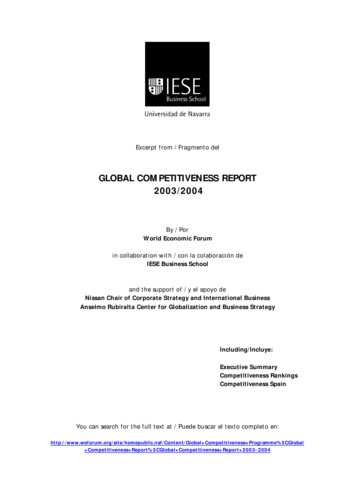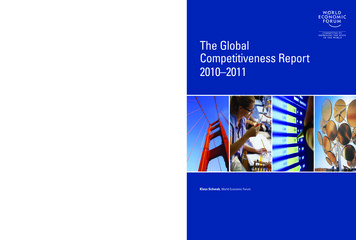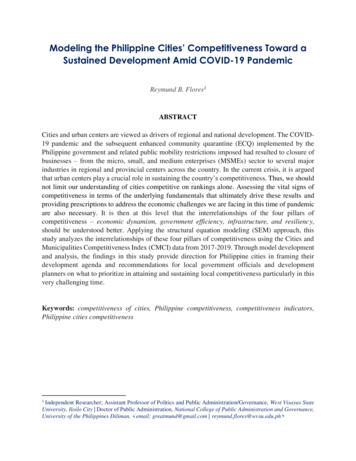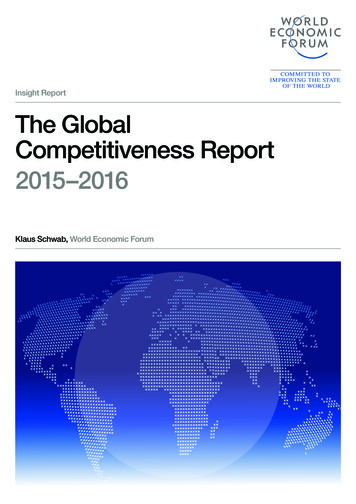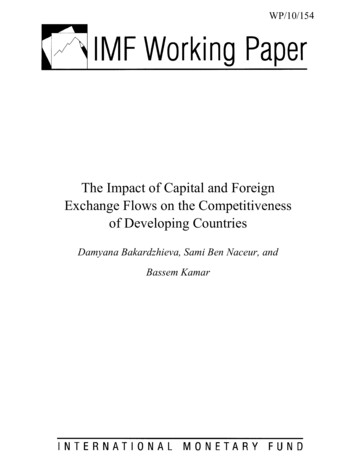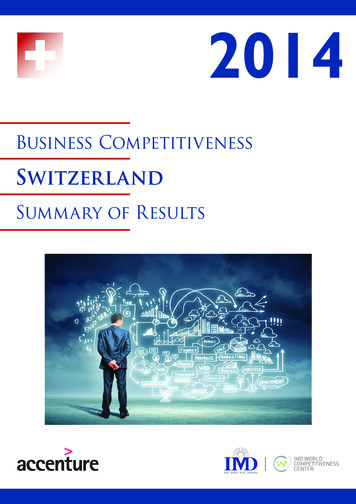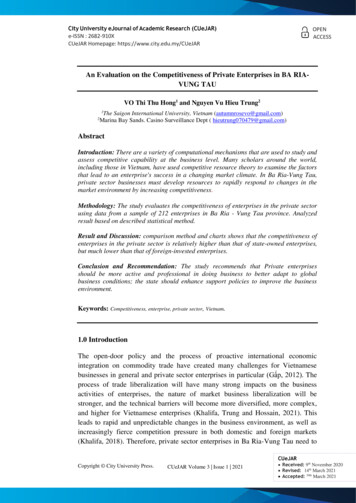
Transcription
City University eJournal of Academic Research (CUeJAR)e-ISSN : 2682-910XCUeJAR Homepage: https://www.city.edu.my/CUeJAROPENACCESSAn Evaluation on the Competitiveness of Private Enterprises in BA RIAVUNG TAUVO Thi Thu Hong1 and Nguyen Vu Hieu Trung21The Saigon International University, Vietnam (autumnrosevo@gmail.com)Marina Bay Sands. Casino Surveillance Dept ( hieutrung070479@gmail.com)2AbstractIntroduction: There are a variety of computational mechanisms that are used to study andassess competitive capability at the business level. Many scholars around the world,including those in Vietnam, have used competitive resource theory to examine the factorsthat lead to an enterprise's success in a changing market climate. In Ba Ria-Vung Tau,private sector businesses must develop resources to rapidly respond to changes in themarket environment by increasing competitiveness.Methodology: The study evaluates the competitiveness of enterprises in the private sectorusing data from a sample of 212 enterprises in Ba Ria - Vung Tau province. Analyzedresult based on described statistical method.Result and Discussion: comparison method and charts shows that the competitiveness ofenterprises in the private sector is relatively higher than that of state-owned enterprises,but much lower than that of foreign-invested enterprises.Conclusion and Recommendation: The study recommends that Private enterprisesshould be more active and professional in doing business to better adapt to globalbusiness conditions; the state should enhance support policies to improve the businessenvironment.Keywords: Competitiveness, enterprise, private sector, Vietnam.1.0 IntroductionThe open-door policy and the process of proactive international economicintegration on commodity trade have created many challenges for Vietnamesebusinesses in general and private sector enterprises in particular (Gấp, 2012). Theprocess of trade liberalization will have many strong impacts on the businessactivities of enterprises, the nature of market business liberalization will bestronger, and the technical barriers will become more diversified, more complex,and higher for Vietnamese enterprises (Khalifa, Trung and Hossain, 2021). Thisleads to rapid and unpredictable changes in the business environment, as well asincreasingly fierce competition pressure in both domestic and foreign markets(Khalifa, 2018). Therefore, private sector enterprises in Ba Ria-Vung Tau need toCUeJARCopyright City University Press.CUeJAR Volume 3 Issue 1 2021 Received: 9th November 2020 Revised: 14th March 2021 Accepted: 30th March 2021
Competitiveness of Private Enterprisescreate resources to quickly adapt to the changes of the business environment bycreating competitiveness (Trung and Khalifa, 2019; Abdulla et al., 2020; Hossainet al., 2020). Therefore, properly assessing the capabilities of enterprises of theprivate sector components in the business environment is always changing; therebyproposing solutions to help these enterprises improve Competitive capability is anurgent issue for enterprises themselves and state management agencies (Hossain,Khalifa and Abu Horaira, 2018; Alseiari, Khalifa and Bhaumick, 2019) in Ba RiaVung Tau in the process of global integration.RESEARCH OBJECTIVESResearch and assess the competitive capability of private sector enterprises incomparison with other economic sectors propose solutions to improve thecompetitive competence of this economic sector in Ba Ria-Vung Tau.2 Literature review2.1. Theory of the factors affecting the Competitive capabilityThere are many theoretical frameworks used to research and analyze Competitivecapability at enterprise level (Khalifa and Abou-Shouk, 2014; Abou-Shouk andKhalifa, 2017; Khalifa and Mewad, 2017; Myo, Khalifa and Aye, 2019). Inparticular, competitive resource theory has been used by many researchers aroundthe world as well as in Vietnam to analyze the factors that contribute to thecompetitiveness of enterprises in a changing business environment (Ke-xin et al.,2006; Abd-Elaziz et al., 2015; Dwyer et al., 2015; Cucculelli and Goffi, 2016;Mohsin Naser A.N. Alharthi et al., 2019; Alseiari, Khalifa and Bhaumick, 2019;M. N. A. N. Alharthi et al., 2020; Khalifa, 2020b; Widjaja, Khalifa andAbuelhassan, 2020).Resource theory of enterprises focuses on analyzing competition based on internalfactors shown in many different forms. Grant (1991) divided them into twogroups: tangible and intangible, in which tangible resources include financialresources such as equity capital and ability to borrow capital of businesses (B. A.F. H. Alharthi et al., 2020); Tangible material sources include tangible productionassets of the enterprise which can bring advantages in production costs such assize, location, technical sophistication, flexibility of production plants, equipment,input materials, Intangible resources include technology (Khalifa and Fawzy,2017; Abdulla et al., 2019; Obeid Alshamsi et al., 2019), reputation (Qoura andKhalifa, 2016), and corporate human resources (Alkathiri, Gamal S.A. Khalifa, etal., 2019; Alsaadi, Abuelhassan, et al., 2019; Khalifa, 2019; Ali Musallam Abdullaet al., 2020; Alshamsi et al., 2020; Rahmah et al., 2020). Resources for technologyinclude intellectual property (Alareefi et al., 2019; Alfalasi et al., 2020; Alkatheeriet al., 2020; Alkheyi et al., 2020), patents (Almarri, Ameen, Bhaumik, et al., 2020;Almarri, Ameen, Isaac, et al., 2020; Alshamsi et al., 2020; Gharama, Khalifa andAl-Shibami, 2020a; Khalifa, 2020a), . Reputation resources include owning awell-known trademark for service quality (Khalifa, 2015; Alghfeli et al., 2019,34CUeJAR Volume 3 Issue 1 2021
Hong and Trung 2021352021; Binnawas, Khalifa and Bhaumick, 2019; Gharama, Khalifa and Al-Shibami,2020b), reliability (Mohamud et al., 2017), and establishing good relationshipswith customers (Alkutbi et al., 2019; Alseiari et al., 2019; Sudigdo, Khalifa andAbuelhassan, 2019; Widjaja, Khalifa and Abuelhassan, 2019), suppliers, banks,authorities, . Human resources include knowledge (Mohsin N.A.N. Alharthi etal., 2019; Almatrooshi et al., 2020; Alneadi et al., 2020; Binnawas, Khalifa andBhaumick, 2020), employee skills (Morsy, Ahmed and Ali, 2016; Mohamed et al.,2018, 2019; Alameri, Ameen, Isaac, et al., 2019), employee suitability withflexibility in strategy (Badran and Khalifa, 2016; Alharthi and Khalifa, 2019;Alharthi, Khalifa and Bhaumick, 2019; Mohamed Naser A.N. Alharthi et al.,2019), employee loyalty (Alkathiri et al., 2018; Nusari et al., 2018; Alkathiri,Abuelhassan, et al., 2019; Alkhateri et al., 2019), . Resource theory is continuallyevolving and expanding in dynamic markets and forming dynamic capacity theory(Al-Ameri et al., 2019; Al-Shibami et al., 2019; Alameri, Ameen, Isaac, et al.,2019; Alameri, Ameen, Khalifa, et al., 2019; O. Alshamsi et al., 2019). Eisenhardt& Martin (2000) pointed out that resources that can be turned into dynamism arethose that satisfy four characteristics: valuable, rare, difficult to replace, anddifficult to imitate, often called VRIN (Valuable, Rare, Inimitable,Nonsubstitutable) for short.There are many studies on factors that are capable of creating dynamic resourcesof enterprises and affecting the competitive competence such as: marketorientation and learning orientation of enterprises (Celuch, Kasouf and Peruvemba,2002; Alsaadi, Khalifa, et al., 2019); creative capacity (Hult, Hurley and Knight,2004; Khalifa and Hewedi, 2016); relationship quality, human resources, materialresources (Sỹ, 2013) ; global orientation, international cooperation, knowledge ofinternational markets, ability to react to international markets (Yeniyurt, Cavusgiland Hult, 2005).In Vietnam, there have been some studies on the impact of dynamic resources onthe competitive competence of enterprises. Specifically, Thành, (2012) proposedevaluation criteria for the competitive competence of enterprises in industry andtrade, including: creative capacity, learning orientation, comprehensive integration,marketing capacity, business orientation and business results. In the study of Hoa,(2009) on dynamic capacity, factors of business orientation, marketing capacity,business results, creativity, learning orientation, prospect of WTO opportunities,financial resources, research and development capacity affect the competitivecompetence of enterprises in Ho Chi Minh City. Hoa, (2009) conducted a researchon dynamic competitive competence model of Siemens Vietnam enterprises whichproved five factors: marketing capacity, business orientation, creativity, serviceorganization capacity and reputation. Business language affects the dynamiccompetitiveness of this enterprise.In summary, there are many factors affecting the competitive competence ofenterprises: (1) relationship, (2) marketing capacity, (3) corporate reputation, (4)research capacity and Development, (5) human resources, (6) physical resources,CUeJAR Volume 3 Issue 1 2021
Competitiveness of Private Enterprises(7) management capacity, and (8) financial capacity that have been shown to havean important influence on the competitive competence of Vietnamese enterprises.Therefore, in this study, the above 8 factors were included in the analysis model bythe author to evaluate the competitive competence according to the constituentfactors of private sector enterprises in Ba Ria-Vung Tau.2.2 Factors comparing competitiveness with main competitorsIn addition to determining the factors affecting the Competitive capability ofprivate sector enterprises in Ba Ria-Vung Tau, the study also assesses thecompetitiveness of these enterprises in comparison with the main competitors. Onemethod that can be used to evaluate the competitiveness of enterprises is thecompetitive polygon graph (Bose and Morin, 2004). This polygon describes theability of a business according to factors in a relation to competitors, or a set ofcompetitors to build an analysis of the enterprise's competitiveness. When thisscheme is stacked, we can quickly gain the relative advantages of enterprises overtheir competitors.Michael (1990) said that enterprises with high competitive competence may havethe following advantages compared to other companies in the same industry, suchas:1. Market share: calculated by value or quantity. The leading companies oftenhave high levels of revenue and market share.2. Scale of operation: measured regularly to assess the growth or decline of acompany in the market.3. Prestige, corporate image: measured by brand awareness as well as brandloyalty.4. Product quality: superior product features, better, reliable, betterperformance.5. Respond to customer requirements: better sales support service, betterproblems handling or complaints from customers.6. Product cost: lower, more competitive than other companies in the sameindustry.7. Effective sales network: groups of customers and sources of informationare created that can directly increase the quality of products or services ofbusinesses.8. Investment in marketing: a series of activities with the purpose of makingcustomers remember the brand, the product, and use the company'sproducts which increases the competitiveness of the private sectorenterprises in Ba Ria-Vung Tau compared with major competitors.9. Research and development capacity: quickly respond to market needs andconsumer preferences, and at the same time be able to quickly modifyproduct improvements according to customer responses to not only reduceprices but also bring consumers better products.10. Management and operating capacity: propose effective strategies torespond to changing business environment.36CUeJAR Volume 3 Issue 1 2021
Hong and Trung 202137In summary, the above 10 factors can clearly show the advantages of enterprises inthe same industry, so this study can be used to evaluate the competitiveness ofprivate sector enterprises in Ba Ria-Vung Tau compared to other main players.3 Methods3.1 Research subject and scopeThe object of the study is the competitive capability of enterprises of the privatesector. Since the number of partnerships is very small and most of them are inVung Tau City, the research selects to survey private sector enterprises that havebeen established and put into operation for more than 3 years up to the time ofresearch in Vung Tau City included: private enterprise, limited liability company(limited company) and joint stock company (JSC).3.2 Methods of data collectionSecondary data: collected mainly from the Department of Planning andInvestment, Department of Industry and Trade, Department of Statistics of Ba RiaVung Tau province, scientific articles, and other relevant research results.Primary data: The thesis uses stratified random sampling method by type ofenterprise, by directly interviewing the head or authorized person to provideinformation at 212 private enterprises. On the basis of determining the rate of eachtype of enterprise from the Ba Ria-Vung Tau Statistical Office to December 31,2018, the study determines the number of each type of enterprise to be surveyedand selects a jump of 10 on the list of 2,138 Private Enterprises of Ba Ria-VungTau Province.Table 1. Sample structure of private sector enterprisesType of enterpriseNumber of enterprises Rate (%) Number of votesPrivate enterprises5772757Co., Ltd1,28360128Joint stock company2781327Total2,138100212(Source: BR-VT Statistics Office 2019)3.3 Methods of data analysisTo measure the influence of each factor, the study uses a 5-level Likert scale, from(1) has absolutely no influence on (5). The significance of each rating levelfluctuates above about 0.8 with each average value of the scale of the influencelevel of the factors determined as follows:(1) 1.00 - 1.80: No effect at all(2) 1.81 - 2.60: No effect(3) 2.61 - 3.40: Normal(4) 3.41 - 4.20: Impact(5) 4.21 - 5.00: Very influential.The study used descriptive statistical methods, methods of comparing the meanvalues of indicators, combining data presentation with charts to evaluate theCUeJAR Volume 3 Issue 1 2021
Competitiveness of Private Enterprisescompetitive competence according to the constituent elements of privateenterprises and assessment of competitiveness of private sector enterprisescompared to main competitors in Ba Ria-Vung Tau.4. Data analysis and Results4.1 Overview of private sector enterprises in Ba Ria-Vung Tau.In general, the speed of formation and development of private sector enterprises inBa Ria-Vung Tau in the period of time from 2017 to 2019 is relatively fast.Specifically, the number of private enterprises in 2018 increased by 27.1%compared to 2017 and continued to increase by 21.1% in 2019, of which thenumber of enterprises with the largest increase was the type of limited liabilitycompany with 28.3% due to favorable mechanism of management, operation andcapital mobilization, followed by JSC with 17.2% due to the policy of acceleratingthe equitization process of state-owned enterprises, and the last is privateenterprise with 8.1% due to the economic situation difficulties leading to manyenterprises going bankrupt.Table 2. Number and production and business capital of private sector enterprises in Ba Ria-VungTau from 018ECE(%)(%)(%)(%)CType ce: Department of Planning & Investment and BR-VT Statistical Office, 2019)As for capital sources, in 2018 the production and business capital of private sectorenterprises also increased sharply, reaching 38.8% compared to 2017. In 2019,although the capital growth rate of private sector enterprises was lower than in2018, it was still at a relatively high level (7.8%), of which the type of Joint StockCompany had the most capital increase with 10.9% followed by limited liabilitycompanies with 5.4% and finally private firms only increased by 2.1%. Thisshows that private sector enterprises are very vulnerable to market fluctuations,especially the effects of economic crisis during this time.Table 3. Average profit / 1 dong of revenue of enterprises in Ba Ria-Vung Tau over the years (Unit:%)38CUeJAR Volume 3 Issue 1 2021
Hong and Trung Private sector enterprisesForeign investment 00Total2.23.192.913.071.2EnterpriseState-owned enterprises(Source: BR-VT Statistics Office 2019)Table 3 presents the average profit per VND revenue (ROS) of all economicsectors in Ba Ria-Vung Tau over the years. In general, in the period 2015-2019,private sector enterprises always have lower ROS than foreign investedenterprises, but higher than state-owned enterprises. This shows that private sectorenterprises are able to control costs better than state-owned enterprises in thisperiod of time.However, in 2019, the profit-to-revenue ratios of businesses in Ba Ria-Vung Tauall decreased significantly compared to 2018. It is noteworthy that private sectorenterprises have the lowest ROS among three economic sectors while there aremany businesses with losses and bankruptcy.Although profit per 1 dong of private sector enterprises' revenue decreased in2019, ROS indicators of private sector enterprises always tended to increase(1.99% in 2015 increased to 3.33. % in 2018) from 2015 to 2019 which provesthese enterprises are increasingly making efforts to improve the ability to manageand control business activities, but still limited in adapting to fluctuations inbusiness environment.4.2 Assessment of competitiveness of private sector enterprises in Ba Ria-Vung Tau4.2.1 Assessment of competitiveness according to constituent factorsOn the theoretical basis presented in section 3.1.1 and survey results of 212 privatesector enterprises in Ba Ria-Vung Tau in 2019, it shows that the competitivecapability of private sector enterprises is relatively strong and has goodcompetitiveness in the country, but International competitiveness is still limitedwith the average score for the 8 components is 3.24. The factor with the largestaverage score is Human Resources (3.66), which shows that private sectorenterprises in Ba Ria-Vung Tau have quite strong and well-developed humanresources. The factors of Relationship, Marketing Competence, Management andExecutive Capacity, Reputation of Enterprises and Physical Resources have arather high average score (over 3.0), which shows that private sector enterpriseshave been significant improvements which are aimed at improving managementcapacity, taking advantage of opportunities for cooperation, support and betterresponse to customer needs. However, the financial capacity and research anddevelopment capacity of private sector enterprises are not highly appreciated,especially the financial capacity factor (2.90), because most of these enterpriseshave the capital at very small and medium level accounting for a very high rate ofover 97.9%. This is also the most restrictive, along with the infrastructureconditions that affect the construction of long-term strategies for investment anddevelopment for private sector enterprises in Ba Ria-Vung Tau.CUeJAR Volume 3 Issue 1 2021
Competitiveness of Private EnterprisesRelationship, (2) marketing capacity, (3) corporate reputation, (4) research capacity andDevelopment, (5) human resources, (6) physical resources, (7) management capacity, and (8)financial capacity that have been shown to have an important influence on the competitivecompetence of Vietnamese enterprises.4.2.2 Assessment of competitiveness against main competitors.The theoretical basis presented in Section 3.1.2 and the survey results show that,generally compared to major competitors, private sector enterprises have relativelystronger capacity in factors such as Customer request effect (3.63), Product andservice quality (3.62), Corporate image reputation (3.57), Executive managementcapacity (3.49), Network efficiency sales net (3.27). This shows that private sectorenterprises are able to adapt well to the business environment through effectivemanagement and operation, sales network efficiency to improve the quality ofproducts and services, network quality, sales network which better meet the needsof customers and contribute to improving the reputation and image of the business.However, for the factors of Investing in Marketing (2.84), Market Share (2.90),Size of Operation (3.09), Research and Development Capacity (3.13), and Price ofproducts and services (3.22), private sector enterprises are not stronger than theircompetitors. The main reason is due to the limited capital factor, the level ofinvestment in marketing, research and development is still low leading to pricecompetitiveness. Expanding market share and operating scale are still limited. Onthe other hand, the quality of human resources has not kept pace with thedevelopment needs in the integration process.40CUeJAR Volume 3 Issue 1 2021
Hong and Trung 202141Figure 2. Assessment of the competitiveness of private sector enterprises in BR-VT compared withmajor competitors. (Source: Actual survey results, 2019)5. SOLUTIONS AND RECOMMENDATIONSThe enhancement of the competitive capability of private sector enterprisesdepends greatly on improving the internal capacities of enterprises themselves andthe supporting policies from the state. Based on the above analysis results, thestudy proposes two groups of solutions:5.1 For private sector enterprisesThe private sector enterprises need to be more proactive and professional inproduction and business activities to adapt well to global business conditions,specifically:- Strengthen product research and development, expand product categories tomeet increasingly diverse and rigorous needs of consumers. If businesses donot meet the buyers' requirements, it is natural that they will lose customers tocompetitors who are able to respond better.- Pay attention to investing in marketing in the direction of promoting researchon consumption trends in the country and the world in order to devise astrategy to make customers remember brands and products of enterprises inthe context of demand. Consumers have many drastic changes compared totheirs before.- Improve and renovate management methods in order to improve the efficiencyof all stages in the production and business process to reduce product costsand regularly update feedback on product quality, customer care services, andwarranty . to better meet the needs of customers.- Improve the quality of human resources of enterprises to meet therequirements of improving customer service capacity on the basis oftechnology innovation, product diversification, product research anddevelopment. . Strengthen training, fostering and developing human resourcesof enterprises with new knowledge and skills in technical and professionalCUeJAR Volume 3 Issue 1 2021
Competitiveness of Private Enterprisesexpertise, the ability to collect and process information to match the scaleoperates in the global business environment.- Improve the understanding and capacity of the head of the enterprise onbusiness administration, and strategic management by regularly updatinginformation, new knowledge and necessary skills such as management skills,skills leadership, change management, skills coping with risks and crises inbusiness, presentation, communication and negotiation skills, . to improvethe competitive capability of private sector enterprises in the market anddevelop markets which are parts of the knowledge economy.5.2 For the stateThe private sector is the most numerous economic sector in the national economy.It is also a dynamic component playing an important role in socio-economicdevelopment, so the State needs to strengthen supportive policies to improve thebusiness environment to help private sector enterprises continue to rise,specifically:- Support private sector enterprises so that they have many opportunities toaccess capital sources by reforming credit mechanisms and policies of banksand encouraging banks to improve lending procedures in a simple, clear, andtransparent way.- Improve the investment and business environment in line with global businesstrends by improving the laws in investment and business to create a healthycompetitive environment and ensure fairness for all economic sectors as wellas providing state and international information to support business in a timelyand accurate manner. Support businesses to open markets and build nationalbrands.- Support for science – technology by enhancing trade promotion, advising onmodern equipment and technology for businesses and being more active andproactive in searching for funding projects, and transferring scientific andtechnological cooperation in advanced countries. Encourage and supportinstitutes and universities in order to strengthen research and application ofscience and technology to production and business.- Support for human resource training and development by investing, renewingvocational training in accordance with the labor supply and demand market,and reducing dependence on cheap labor in order to upgrade the quality ofhuman resources to improve labor productivity, maintain and promote thecompetitive competence of enterprises.- Support for infrastructure and business services by increasing investment toperfect the transport system, telecommunications, warehouse services,transportation, . Simple, open and transparent administrative procedures areapplied to create the best favorable conditions for private sector enterprises inBa Ria-Vung Tau to participate in developing production and business andcontribute to improving the competitive capability of the province.42CUeJAR Volume 3 Issue 1 2021
Hong and Trung 2021436 ConclusionsThe development of private sector in a socialist-oriented market economy hasbecome an inevitable trend and an important constituent part of the unifiednational economy which is interested by the Party and State. Many policies havebeen issued to encourage the development. In recent years, with the attention andsupport of the State, private sector enterprises in Ba Ria- Vung Tau have been andwill be increasingly developing that hold an important position in the process ofsocio-economic development. However, the development potential of privatesector is still very great. For private sector enterprises to make importantcontributions to the development of the province, it is necessary to synchronouslyimplement the above solutions to remove difficulties and continue improving thecompetitive capability of private sector enterprises. This contributes to promotingBa Ria- Vung Tau to become an economic - cultural center, an education - trainingand science - technology center of the key economic region of the South ofVietnam.ReferencesAbd-Elaziz, M. E. et al. (2015) ‘Determinants of Electronic word of mouth (EWOM) influence onhotel customers’ purchasing decision’, International Journal of Heritage, Tourism, andHospitality, 9(2/2), pp. 194–223.Abdulla, S. A. M. et al. (2019) ‘Antecedents of Dubai Revisit Intention: The Role of DestinationService Quality and Tourist Satisfaction’, Restaurant Business, 118(10), pp. 307–316.Available at: /view/9326.Abdulla, S. A. M. et al. (2020) ‘Advancement of Destination Service Quality ManagementTechnology in Tourism industry’, Journal of Critical Reviews, 7(11), pp. 2317–2324. doi:doi:10.31838/jcr.07.19.351.Abou-Shouk, M. A. and Khalifa, G. S. (2017) ‘The influence of website quality dimensions on epurchasing behaviour and e-loyalty: a comparative study of Egyptian travel agents andhotels’, Journal of Travel and Tourism Marketing, 34(5), pp. 608–623. Al-Ameri, J. et al. (2019) ‘Towards a Better Understanding of the Relationship between Training,Access Resource, and Self-sufficient: The Case of Developing Countries’, Test Engineeringand Management, 81(November-December 2019), pp. 1953 –1958.Al-Shibami, A. H. et al. (2019) ‘Impact of Organizational Culture on Transformational Leadershipand Organizational Performance’, International Journal of Recent Technology andEngineering, 8(2S10), pp. 653–664.Alameri, M., Ameen, A., Isaac, O., et al. (2019) ‘Examining the Moderating influence of JobComplexity on the Relationships between Empowering Leadership and OrganizationalInnovation’, Test Engineering and Management, 81(1), pp. 1930 –1937.Alameri, M., Ameen, A., Khalifa, G. S., et al. (2019) ‘The Mediating Effect of Creative SelfEfficacy on the Relation between Empowering Leadership and Organizational Innovation’,Test Engineering and Management, 81(1), pp. 1938– 1946.Alareefi, N. A. O. M. et al. (2019) ‘Employee’s Innovative Behaviour: Evidence from HospitalityIndustry’, Pakistan Journal of Social Sciences, 16(1), pp. 14–29. doi:10.3923/pjssci.2019.14.29.Alfalasi, K. et al. (2020) ‘Impact of Actual usage of Smart Government on the Net Benefits(Knowledge Acquisition, Communication Quality, Competence, Productivity, DecisionQuality)’, Test Engineering and Management, 82, pp. 14770 – 14782.Alghfeli, A. H. et al. (2021) ‘The influence of Service Quality and Trust in Consultant on PMCperformance in Public Sector’, City University eJournal of Academic Research (CUeJAR),2(2), pp. 175–190.Alghfeli, A. H. S. M. et al. (2019) ‘The Effect of B2B SERVQUAL on PMC Performance: TheMediating Role of Top Management Support in UAE Executive Council’, InternationalCUeJAR Volume 3 Issue 1 2021
Competitiveness of Private EnterprisesJournal of Recent Technology and Engineering. Blue Eyes Intelligence Engineering andSciences En
In Ba Ria-Vung Tau, private sector businesses must develop resources to rapidly respond to changes in the market environment by increasing competitiveness. Methodology: The study evaluates the competitiveness of enterprises in the private sector using data from a sample of 212 enterprises in Ba Ria - Vung Tau province. Analyzed


